- Travel + Photos
- Voyages
- Jordan + Jerusalem
The Hashemite Kingdom of Jordan + Jerusalem
I bought the airplane ticket for Jordan one month prior to the trip, but things were so hectic in my life the month preceding the trip that I never had time to prepare for it. I knew that I wanted to visit Petra and the desert of Wadi Rum and that was it. Three days before my departure, I booked a hotel in downtown Amman for the first two nights. That was all the preparation I had for this trip.
04 Oct

Having gone out with my brother in Paris the previous two nights and having to wake up very early this morning, I am (already) a little tired but glad to leave. It is only until I saw Beirut from the airplane, after the announcement of the pilot, that I realize that I am now in the Middle East and that the trip has really started.
At the immigration in Amman, they make me wait more than an hour. All other passengers have been long gone and I am still waiting. Finally a senior officer comes out to tell me that my passport is not valid and consequently I can not enter the country! All that troubles because I have an old passport that does not scan. I have to convince him that my passport is indeed valid and he ends up let me through. Whew!
It is now almost two hours after my arrival, I can not find on exit the driver that the hotel was supposed to send to pick me up. It is only the first day and already things resemble too much to those of the past 4-5 weeks. I start to wonder if this trip would be a complete disaster.
Now, I expect that people would swarm me, would harass me and would try to dupe me like in certain countries. Nothing. I am left alone; first good surprise. I buy a telephone card, the guy at the information booth helps me call the hotel and the driver comes back to pick me up.
05 Oct

Visit on foot this morning of the Roman Theatre and of the Citadel of Amman. The amphitheatre, a remnant of Philadelphia Roman, is itself cut into a hill and uses the natural slope for its gradins. Climbing its stairs, I realize how steep the hills of Amman are.
While walking up to the Citadel, I cross some school boys who ask me to take them in picture. When crossing another group, one of them offer me some cheetos that I accept with no hesitation. Of course, the whole thing finishes with a picture. Decidedly, Jordanian kids do like to have their pictures taken.
The Citadel is located at the top of the highest hill in Amman, Jebel al-Qala'a, about 850 m (2790 ft) above sea level. From there, one can have nice views of Amman and that of the biggest flag on a flagpole in the world.
I start to find out how friendly and hospitable people are. Some offer me to join their table for lunch after they saw me taking a picture of them. Two others help me catch a service taxi (a shared taxi with fixed itinerary and fare), and make sure that the driver, who does not speak English, knows my destination.
06 Oct
I had planned on visiting Jerash and the North of Jordan today, Tuesday, then going to Jerusalem tomorrow and coming back to Jordan on Saturday. This morning I realized that coming back on Saturday is not an option because of Shabbat: the Egged bus does not run. That is all right, I can extend my stay in Israel one day by first going to Lake Tiberias tomorrow before heading to Jerusalem.
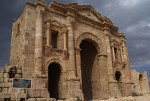
I took a tour with the Palace Hotel (the tour only provides transportation for Jerash, Ajloun and Umm Qais, and no guide), thinking that I could be dropped off in the university town of Irbid at the end of the day. But since we visit Jerash (further south and closer to Amman) last, the plan does not work out.
Umm Qais is located in the northwest corner of Jordan close to the Syrian and Israeli borders, therefore there are numerous military check-points on the roads. From the archeological site of Umn Qais (ruins of the ancient city of Gadara), one can see Lake Tiberias in Israel and the Golan Heights. The lake is a pilgrim destination for Christians and Jews; it is something to think that is there that Jesus has supposedly walked on water.
We were a bit slow and arrive in Jerash around 3:30 PM, which turned out not too bad as the late light is better for the pictures. The site is the most impressive of the ones visited so far in Jordan. By taking our time, the visit took about 2:30 hours.
I wanted to stay overnight in Jerash in order to take the north border-crossing (Sheikh Hussein/Jordan bridge) the next morning, but the hotel does not have any vacancy and I have to return to Amman with the group. Fortunately, I was able to get a room in the same hotel in Amman (the lady actually gave me a double room for the price of a single!).
07 Oct
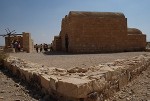
I have decided to stay one more night in Amman in order to visit the desert castles today. Just like yesterday, I take a tour with the hotel because public transportation to the East of the country is rather scarce. As part of the program are the castles of Qasr Kharana, Qusayr Amra and Qasr al-Azraq. Florence, whom I met two days earlier, has convinced the hotel to also include the Azraq Wetland Reserve, which is normally not part of the program.
The first two castles look very unimpressive from the outside, but their beauty is really from the inside, especially Qusayr Amra with its frescoes.
Thanks to Florence, a birdwatcher, I observe birds for the first time at the Azraq Wetland Reserve. I have to admit that it is quite nice and relaxing. However, I doubt I would stay out in the cold for hours watching birds.
08 Oct
One would think that with the passport problem I had the first day and my first failed tentative to make it to Jerusalem, I would wisely stay in Jordan. No. I wonder though if it is possible to get stuck in no man's land because the Israelis don't let me in and the Jordanians don't let me return!
9:15 AM: Taxi to Tabarbour bus station, north of Amman: 1.6 JD.
9:35 AM: Arriving at the bus station. Five minutes later, the service taxi fills up and leaves for the border: 5 JD.
10:30 AM: Arriving at the border. The exit tax is 5 JD. One is not allowed to cross the bridge on foot, I have to wait for the shuttle bus.
11:30 AM: The shuttle bus comes and we leave for Israel, or Palestine depending on whom you talk to. 3 JD for the bus and 1 JD for each luggage, what a rip off.
 11:40 AM: Arriving to the Israeli side of the border. One must get in line to leave the luggage for the security scan, then go to the immigration. There, one must wait. I notice that the Israelis working there are very young, late teens in age. There is one queue for tourists and one for the Palestinians. The guy in charge of the queues is rude and very impolite with the Palestinians.
11:40 AM: Arriving to the Israeli side of the border. One must get in line to leave the luggage for the security scan, then go to the immigration. There, one must wait. I notice that the Israelis working there are very young, late teens in age. There is one queue for tourists and one for the Palestinians. The guy in charge of the queues is rude and very impolite with the Palestinians.
12:40 PM: It is my turn to go to the immigration window #2. The girl working at that window seems a little rude. After ~7 minutes wait, the person over window #3 is available and calls me up. She is a rather cute young girl and seems to be nicer than the other one. After only about 10 minutes of interrogation, she lets me through. I go to get my bag back.
1:10 PM: I take a sherout (shared taxi) for Jerusalem. Having no shekel, I pay in euro: €8. My non-calibrated altimeter watch indicates -247 m (-810 ft).
2:30 PM: Arriving to the hotel. It is actually 1:30 PM local time, but I do not know that yet. It took me 5 hours from door to door, or about 4 hours from Amman to Jerusalem. The distance as the crow flies between the two cities is 70 km (45 mi).
First impression of Jerusalem: police check-point just outside of the Damascus gate. Policemen carry assault rifles. It feels almost like a besieged city.
Second impression: the streets are rather small, more like alleys than streets. What appears on the map as a main artery of the Old City is actually just a covered alley. It is not easy to navigate in the Old City as one can not see and use the landmarks as a mean of orientation.
9 Oct
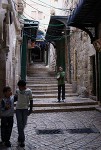
Big surprise this morning when stepping out of the hotel: the street filled with people yesterday is completely empty. After several seconds, I realize that it is Friday and consequently everything, or almost, is closed in the Muslim quarter of the Old City.
Arriving close to Temple Mount, I encounter a police barrage and learn that it is closed to the public, thus it is not possible to visit the Dome of the Rock. In fact, it has been closed for some time and the recent shooting there (less than a week) did not help the situation. A shame.
There is a big crowd at the Wailing Wall (or Western Wall, as it is the wall on the west side of the Temple) and the people are very fervent. The wall is divided into two sections, the bigger one is for men and the other is for women. After a long hesitation, I decide to join the crowd in order to better feel the emotion and for a better pictures vantage point.
The entrance ticket for the David Tower Museum includes a free guided tour. I am told that the next tour takes place at 11:00 AM, however it is already 11:30 on my watch. I must look puzzled like someone who has just been dropped off on a foreign planet because the cashier tells me then that it is 10:30 AM and the tour will take place in half an hour. I kept the Jordanian time on my watch without knowing that there is no day light saving in Israel, thus Israel is one hour behind even though it is west of Jordan!
The crowd at the Church of the Holy Sepulchre is very fervent as well. There is a long line for the Edicule of the Holy Sepulchre (tomb of Christ) and for the Crucifixion Altar. Almost everybody kisses the Stone of the Unction on entering or exiting the church.
To change things up a little, I try out Albanian cuisine for dinner; not bad at all.
10 Oct
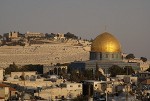
I like taking my time at breakfast on the roof-terrace of the al-Hashimi hotel. I appreciate the view, the cool wind and warm light of the morning and the chant of the playful birds. Life is pleasant.
The Muslim quarter is animated anew today, the Christian quarter is normal, but the remaining of Jerusalem is almost dead because of Shabbat. Today is a museums day.
Not to be missed at the Israel Museum are the Dead Sea Scrolls in the Shrine of the Book. Notably, the Great Isaiah Scroll is the most important biblical manuscript and is more than 1000 years older than any other ancient biblical texts found. The exposition of the masks of the world is also very interesting.
I have read that taxi in Jerusalem is expensive and taxi drivers are known for charging excessive fares. Thus one must always ask them to use the meter and try to know in advance the way to destination as well as the adjacent streets so to know when they take unnecessary detour. I did not have any trouble when going to the Israel Museum. As for the return, the taxi drivers outside the museum refuse to use the meter and ask for an exorbitant fare, knowing that public transportation, alternative solution, is reduced to minimum on Shabbat. After a long negotiation and several threats from my part to just walk back to the Old City, one of them concedes for an acceptable fare.
City Centre becomes more animated at the end of Shabbat, as the sun goes down. People go out on the street, stores and restaurants open, City Centre is filled with life again.
All the time I was in Jerusalem, I never saw any interaction between Jews and Muslims, even though they live right next to each other.
11 Oct
I would have liked to spend more time on the terrace this morning, but it is time to leave. I take a city bus to the Central Bus Station, then an Egged bus for Eliat in the South. One must pass the security scan before entering the Central Bus Station. Inside, there are a lot of young militaries carrying backpack and weapons, going back to their garrison or whatever. It is funny to see a young pretty girl in uniform and sandals, carrying an assault rifle on one side and pulling a luggage on the other.
The situation at the bus station is chaotic and confusing. There are three buses leaving for Eliat at the same time instead of just one as I thought. Finally, I find my bus. The road goes along the border of the Dead Sea (that I see for the first time), almost touching the water at places. The sea is pretty with a turquoise colour and a white border from the salt deposit. At one point, I see -301 m on my altimeter (the Dead Sea is actually 408 m (1338 ft) below sea level).
Since I don't have enough shekels left to pay for a taxi from Eliat to the Jordanian border, I try to get the bus driver to let me off at the intersection with the road to the border (I have read that people do that). Three times I ask him, and three times he says no with different reasons. At the third time, Daniel, an Israeli seating in front of me, jumps in and explains in Hebrew to the driver what exactly I want. After several minutes of discussion where they shout almost at each other, the driver agrees.

There are about 2 km (1.2 mi) from where I get off the bus to the Jordanian border. I walk with my bags, in the heat: it is tiring. I try to hitch-hike but only taxis go there. When I arrive at the border, a taxi driver who passed me earlier, tells me with a smile: that's a good walk
. Well, thanks, I know.
The Lonely Planet says that the Israeli exit tax at the South border crossing (Arava/Wadi Araba) is 68 NIS. In fact, it costs 90 NIS; what an inflation! The 70 shekels that I kept are not sufficient, so I have to pay the difference in US dollars, which is a big rip off with the exchange rate they do. Finally, the border crossing here does not pose any problem and the whole thing takes 30 minutes or so.
I arrive to Wadi Rum by taxi after the sunset. Na'el comes pick me up at the border of the road and take me to the Bedouin camp run by his father. The half-moon has not yet risen, it is all dark and I wonder how he recognizes his way through the sand of the desert. At times, the light of his pickup truck goes out and he uses a flashlight to light the road!
I arrive to camp just in time for dinner. It is chicken that they cook in the sand for several hours; it is tender, juicy and delicious.
There are three young British (Arab origin) couples at the camp. One of them is an investor in Iraq and lives in Basra with his wife for two months now. He has some interesting inside stories on Iraq. With the Bedouins at the camp and another Polish couple, we spend the night singing, playing games and smoking the shisha (Arabic for nargileh). I do not like tobacco, but I must say that I enjoy the fruity shisha.
12 Oct
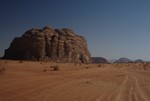
The night feels cold, fortunately I have a very warm blanket. However when I look at the thermometer on my watch around 5 AM, it is 15ºC (59ºF). It must be the difference in temperature with the day that makes it feel that cold.
The British and Polish leave this morning. I take a little 4WD excursion in the morning and another one in the afternoon with a Belgian family that arrives to camp around mid-day. The 4WD excursion covers more terrain and allows seeing more places. However, I would have like to have more time exploring on foot in order to really appreciate the desert. I also find it a bit pity that there are car tracks everywhere in the desert, but one can not have 4WD excursions without leaving tyre tracks.
Just like the night before, I stay outside watching stars before going to bed. I have never seen that many stars, that bright and clearly. The Milky Way is magnificent.
For some reasons, I like staying in the desert. I like sleeping in a tent on the sand. I love the sky at night. There is nothing in the desert. What really matters is the basic needs such are water and food. Life is harsher but also simpler, and perhaps that is what I like.
13 Oct
It is 25ºC (77ºF) at 8 AM this morning and I feel a little cold in the shade of the tent at breakfast.
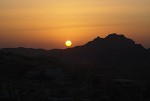
I have read that there is a minibus leaving the Visitor Centre at 8:30 AM for Petra, but at the camp, they assure me that there is another one leaving at 9:30. They drive me to the Visitor Centre a little after 9. After 40 minutes of wait, I realize there is no other bus for Petra, which is confirmed by the Visitor Centre.
I do not have enough cash to hire a taxi. An employee at the Visitor Centre advices me to hitch-hike to the Desert Highway (30 km, 19 mi) where I would have more chance to catch a bus to Petra or Ma'an. Ma'an being a bigger city, has more frequent buses going to Petra.
I hitch two cars to get to the Desert Highway. There I meet a Jordanian who has been waiting for more than two hours for a bus to Petra. He convinces me that it takes much more time to go through Ma'an. After hitching with two more cars, I arrive in Petra. The whole thing costs me 3.5 JD (it is of custom for drivers to take a fee from hitch-hikers), cheaper than the fare of a minibus, but I arrive to destination much later than expected.
Hitch-hiking is not that easy. First off, you have to wait on the shoulder of the road under the strong sun of the South of Jordan with no shade. Then there are questionable people who stop that you need to recognize.
14 Oct
After more than nine hours of sleep, I am still tired. I wake up a little late for the 7 AM shuttle, and thus take the 8 AM shuttle for Petra. With two 1.5L water bottles, lunch and camera gear, my backpack must weight at least 7 kg (16 lbs); it is heavy.
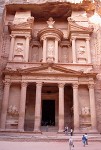
There are a lot of people and that hinders my pleasure of discovering the Treasury at the end of the Siq. According to the Lonely Planet, there is a steep trail on the left side that leads to the top for a vertiginous view of the Treasury. I start to scramble up the trail with some difficulties when a ranger makes me come down. The trail has been closed because it is too hazardous.
I take the High Place of Sacrifice trail in the morning and hike up to the Monastery in the afternoon. Walking up and down the trails in Petra and examining closer the monuments, I start to appreciate the enormity and the beauty of the place. If I am tired just walking up the slopes, then imagine the efforts necessary to the Nabataeans to carve those monuments more than two thousand years ago; yes, almost every monument is cut out of the rocks. The geology of Petra is also very interesting. The sandstone rocks show superb colours.
A lot of donkeys carry people up to the Monastery and they shove those who walk. Their excrements are scattered all over the trail and it stinks!
While going down from the Monastery, I accept the invitation of some Bedouins to have tea and smoke the shisha with them. They seem to appreciate the fact that I inhale when smoking. A little further, a small Bedouin girl asks to try on my sunglasses. She has a movement of surprise when putting on my sunglasses, probably surprised by the darker view produced by the glasses. I wonder if it is her first time putting on sunglasses.
I have apparently spent a lot of energies during the day because I eat a lot at dinner. At the buffet, a big plate full of food (that normally I would not be able finish) is not sufficient to calm my hunger, I need another half-plate to be satisfied.
15 Oct
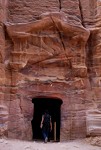
I take the 7 AM shuttle today. The Siq is mostly empty this morning which makes it much more enjoyable for me. This time, the apparition of the Treasury is more magical. I take the trail next to the Palace Tomb that goes up to the top of the plateau for a view from above of the Treasury.
On the way back, I stop to have tea with a Bedouin, Promess, in his cave on the plateau. Also present at the tea party
are Promess' cousin and a New Zealander tourist, Ingrid. Sitting at the border of the cliff, Promess plays the flute, his cousin sings. The canyon echoes back the chant, making the moment a little magical. Promess invites me to come back and sleep in his cave whenever I want, but due to time constraint, I can not make it.
I spend the remaining of the morning with Ingrid. At one time, we engage in a conversation with a Bedouin lady who has five kids. She does not speak English well, but from her gestures, I think understand that she wants to give her youngest child to Ingrid for adoption! She ends up giving us as present, some multicolour rocks from Petra.
We explore a section of Wadi Siyagh up to the small spring. Contrary to the rest of Petra, Wadi Siyagh has a lot of trees, which makes it cooler and attracts a lot of birds. Being an ornithologist, Ingrid identifies the birds and show them to me with her binocular. We have lunch on a big rock next to the spring, in the middle of the bird chants; it is very pleasant.
In the afternoon, I visit Petra church and the magnificent Royal Tombs. What I find surprising and a real pity is the waste found inside the tombs and monuments (in Petra as well as at other sites in Jordan).
16 Oct
The minibus leaves at 6:30 this morning and arrives to Amman around 10 AM. I share a taxi with an English woman to Madaba where I meet up again with Florence. We spend the afternoon visiting the Archeological Park, the Church of the Apostles and Madaba Museum.
At the Church of the Apostles, the guard allows us to walk on the mosaics in order to take pictures. It is quite surprising considering that these mosaics are from the 6th century. At the Madaba Museum, not only the guard allows us to walk on the mosaics, but he also cleans them (with a water spray) before letting us take pictures.
17 Oct
I hire a car for two days (the minimum rental duration required). Our plan is to drive to the Dead Sea Panorama Complex, descend to the Dead Sea, go to the Wadi Mujid Reserve, then see what the time permits us to do.
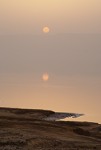
After visiting the museum at the Panorama Complex, we head to the restaurant for lunch. Once we ordered our food, we notice a big commotion in the restaurant. Men with an earbud in their ear and policemen come in, eat and leave. In the meantime, we are still not served after almost an hour. I tell Florence, kidding, that we should just help ourself at the buffet that has been set up next to our table. It turns out that all the commotions are due to the presence at the Complex of King Abdullah Hussein. Apparently, the King and his brother like riding motorcycle along the Dead Sea and often stop at the Panorama Complex for lunch. The King invites everyone to share his buffet. He even pays our bill! At the end of the meal, he passes say hello to everybody.
After the King's departure, the waiters become more relaxed and smiling. As we are about to leave, we are intercepted by the King's cooks who offer us desserts for the road. They like to pose in picture with Florence. Later, we were stopping on the side of the road, taking pictures, when we see several heads popping out of the windows of a big SUV passing by; that is the King's cooks waving goodbye to us. Nice.
Not having enough time to go to Wadi Mujid Canyon on the King Highway, we decide to stay at the Dead Sea for the sunset. I was able to experience swimming in the Dead Sea thanks to a Jordanian who was kind enough to let me use his fresh water for rinsing after the swim. The sea is so salted that I am able to float without doing anything, me who always sink in the water.
We indulge ourselves to a hammam (Turkish bath) in the evening for relaxation. It starts with the jacuzzi, then the sauna and finishes with a massage.
18 Oct
Last day. After dropping off Florence at the bus station, I take the King Highway and head to Wadi Mujid Canyon. At its view, I understand why people call it the Grand Canyon of Jordan
.
It is quite smoggy today and the view from Mount Nebo is not that great. On a day like today, Moses would probably not have seen the Promised Land either.
Temperature is around 35ºC (95ºF) when I leave Jordan. When the pilot announces that temperature in Vienna is 6ºC (43ºF), I realize with some regret that the trip has come to an end.
Practical Details
Dates of the trip: 4-18 Oct 2009
The Jordanian dinar (JD) is stronger than I expected and Jordan is relatively not a cheap destination. The new Israeli shekel (NIS) is not as strong, however living cost is much higher in Jerusalem than in Jordan. The exchange rates during my journey: 1 JD = US $1.4, 1 JD = €1 -- US $1 = 3.8 NIS, €1 = 5.6 NIS.
In bigger cities (Amman, Madaba, Petra and Aqaba), it is relatively easy to find an ATM accepting Visa, MasterCard, Cirrus and Plus cards. There is no ATM in Wadi Rum. Most of the stores and restaurants do not accept credit cards.
It is less expensive to travel in group in Jordan. The cost for private transportation is per vehicle, hence the cost is the same whether you are alone or several.
The telephone card is not very practical because it is not easy to find public phones. Some are kind enough to lend me their mobile phone so that I can make a call with my card, but that is certainly not the norm. A better solution is to buy a prepaid SIM card (as cheap as 5 JD) to be used with one's own GSM mobile phone. I would have brought my mobile had I known.
Hotels
- Palace Hotel, Amman
- Backpacker hotel with a lounge that facilitates meeting with other fellow travelers. The cleaness of the rooms are acceptable (do not examine the sheets too closely). Very good price for the tours. Visa cards are accepted.
- Al-Hashimi Hotel, Jerusalem
- Listed as budget hotel by the Lonely Planet, the rates are actually higher than indicated in the book, probably as the result of recent renovations. The rooms are very clean with abundance of marble. Conveniently located in the heart of the Old City with a superb view from the roof-terrace.
- Valentine Inn, Petra.
- Cleaness of the rooms is acceptable. The buffet at dinner allows meeting with other travelers. The hotel provides free shuttles to Petra and gets the minibuses to come to the hotel if there are enough people for a given destination, which spares its guests the walk to the bus stations.
- Moab Land Hotel, Madaba
- Nice view on the terrace where breakfast is served. Front desk staff can be rude.
- Madaba Hotel, Madaba
- Very relaxed, functions more like a pension than a hotel. Very cheap rates with superb rooms. Best value on this trip.
Links
- L'oiseau de passage
- Florence's blog on her two month long journey across Greece and Jordan.
- Visit Jordan
- The official website of the Jordan Tourism Board.
- Egged Bus
- Routes and schedule for Egged buses in Israel.
Copyright © 2009, Northwest Summit. All rights reserved.
No part of this page may be reproduced, republished or copied without the express written permission of its author.





